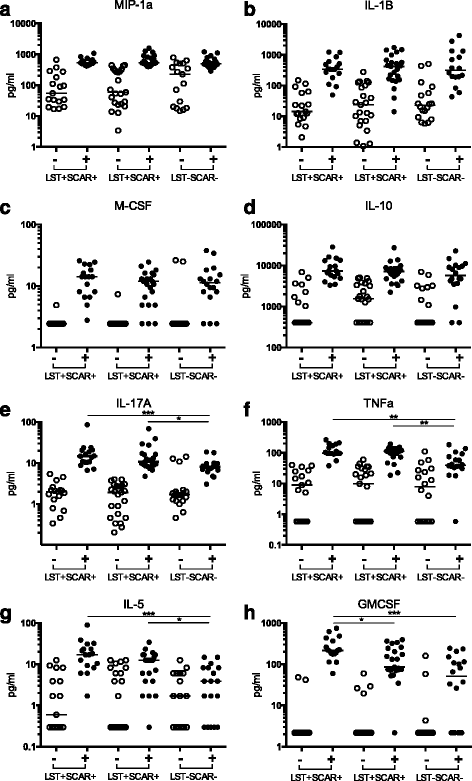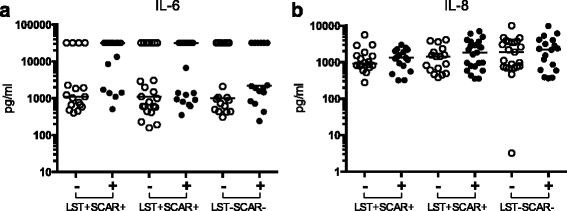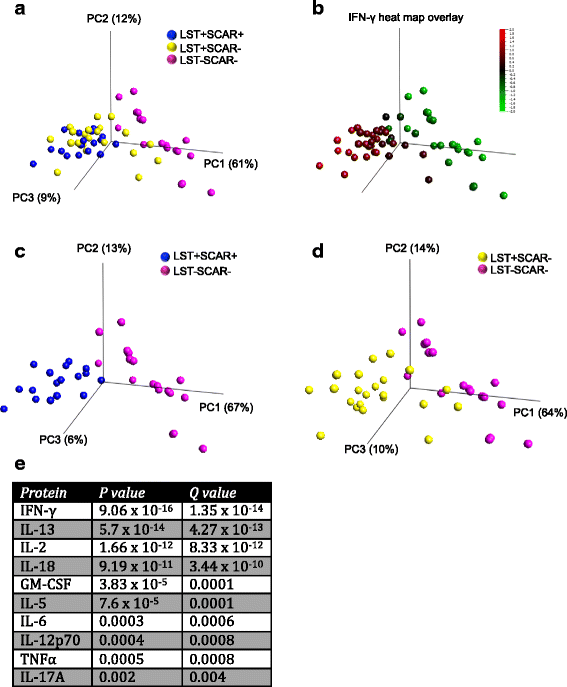Protein biomarkers discriminate Leishmania major-infected and non-infected individuals in areas endemic for cutaneous leishmaniasis
- PMID: 27009263
- PMCID: PMC4806467
- DOI: 10.1186/s12879-016-1458-6
Protein biomarkers discriminate Leishmania major-infected and non-infected individuals in areas endemic for cutaneous leishmaniasis
Abstract
Background: A successful host immune response to infection is dependent upon both innate and adaptive immune effector mechanisms. Cutaneous leishmaniasis results in an adaptive Th1 CD4(+) T cell response that efficiently clears the parasite, but may also result in scaring. However the role of innate mechanisms during parasite clearance remains less well defined.
Methods: We examined a unique cohort of individuals, living in a Leishmania major endemic region, that were stratified among 3 distinct clinical groups in a cross-sectional study. Specifically, patients were classified either as healed (n = 17), asymptomatic (23), or naïve to infection (18) based upon the classical Leishmanin Skin Test (LST) and the presence or absence of scars. Utilizing a multiplexed immunoassay approach we characterized the induced cytokine and chemokine response to L. major.
Results: A subset of innate immune molecules was induced in all groups. By contrast, T cell-associated cytokines were largely induced in exposed groups as compared to L. major-infection naïve individuals. Two exceptions were IL-17A and IL-12p70, induced and not induced, respectively, in naïve individuals. In addition, GM-CSF was more strongly induced in healed patients as compared to the other two groups. Surprisingly an IL-13 response was the best cytokine for classifying previously infected donors.
Conclusions: Exploratory data analysis, utilizing principle component analysis (PCA), revealed distinct patient clusters of the healed and naïve groups based on the most differentially induced proteins. Asymptomatic previously infected individuals were more difficult to assign to a particular cluster based on these induced proteins. Analysis of these proteins may enable the identification of biomarkers associated with disease, leading to a better understanding of the protective mechanisms of immune response against leishmaniasis.
Keywords: Asymptomatic infection; Leishmaniasis; Protein biomarkers.
Figures




Similar articles
-
Leishmanin skin test lymphoproliferative responses and cytokine production after symptomatic or asymptomatic Leishmania major infection in Tunisia.Clin Exp Immunol. 1999 Apr;116(1):127-32. doi: 10.1046/j.1365-2249.1999.00844.x. Clin Exp Immunol. 1999. PMID: 10209516 Free PMC article.
-
Human cellular and humoral immune responses to Phlebotomus papatasi salivary gland antigens in endemic areas differing in prevalence of Leishmania major infection.PLoS Negl Trop Dis. 2017 Oct 12;11(10):e0005905. doi: 10.1371/journal.pntd.0005905. eCollection 2017 Oct. PLoS Negl Trop Dis. 2017. PMID: 29023574 Free PMC article.
-
[Concordance of leishmaniasis cutaneous tests in Tunisia].Arch Inst Pasteur Tunis. 2001;78(1-4):11-6. Arch Inst Pasteur Tunis. 2001. PMID: 14658234 French.
-
Distinct immunological states in murine cutaneous leishmaniasis by immunising with different amounts of antigen: the generation of beneficial, potentially harmful, harmful and potentially extremely harmful states.Behring Inst Mitt. 1997 Feb;(98):153-9. Behring Inst Mitt. 1997. PMID: 9382736 Review.
-
[Immunopathology of American tegumentary leishmaniasis].Acta Cient Venez. 1998;49(1):42-56. Acta Cient Venez. 1998. PMID: 10205916 Review. Spanish.
Cited by
-
Biomarkers of Cutaneous Leishmaniasis.Front Cell Infect Microbiol. 2018 Jun 26;8:222. doi: 10.3389/fcimb.2018.00222. eCollection 2018. Front Cell Infect Microbiol. 2018. PMID: 29998089 Free PMC article. Review.
-
Design of multi-epitope peptides containing HLA class-I and class-II-restricted epitopes derived from immunogenic Leishmania proteins, and evaluation of CD4+ and CD8+ T cell responses induced in cured cutaneous leishmaniasis subjects.PLoS Negl Trop Dis. 2020 Mar 16;14(3):e0008093. doi: 10.1371/journal.pntd.0008093. eCollection 2020 Mar. PLoS Negl Trop Dis. 2020. PMID: 32176691 Free PMC article.
-
A Prospective cohort study of zoonotic cutaneous leishmaniasis in tunisia: Clinical and Immunological features and immune correlates of protection.PLoS Negl Trop Dis. 2023 Dec 8;17(12):e0011784. doi: 10.1371/journal.pntd.0011784. eCollection 2023 Dec. PLoS Negl Trop Dis. 2023. PMID: 38064516 Free PMC article.
-
Potential biomarkers of immune protection in human leishmaniasis.Med Microbiol Immunol. 2021 Jun;210(2-3):81-100. doi: 10.1007/s00430-021-00703-8. Epub 2021 May 2. Med Microbiol Immunol. 2021. PMID: 33934238 Free PMC article. Review.
-
Immunomodulatory and biological properties of helminth-derived small molecules: Potential applications in diagnostics and therapeutics.Front Parasitol. 2022 Sep 9;1:984152. doi: 10.3389/fpara.2022.984152. eCollection 2022. Front Parasitol. 2022. PMID: 39816468 Free PMC article. Review.
References
-
- WHO. Control of the leishmaniasis Report 2010
-
- WHO | Leishmaniasis.
-
- WHO EMRO | Cutaneous leishmaniasis caused by Leishmania major in Morocco: still a topical question | Volume 19, issue 5 | EMHJ volume 19, 2013. - PubMed
-
- Ben Salah A, Louzir H, Chlif S, Mokni M, Zaatour A, Raouene M, Ismail R Ben, Dellagi K. The predictive validity of naturally acquired delayed-type hypersensitivity to leishmanin in resistance to Leishmania major-associated cutaneous leishmaniasis. J Infect Dis. 2005;192:1981–7. - PubMed
Publication types
MeSH terms
Substances
Grants and funding
LinkOut - more resources
Full Text Sources
Other Literature Sources
Research Materials

